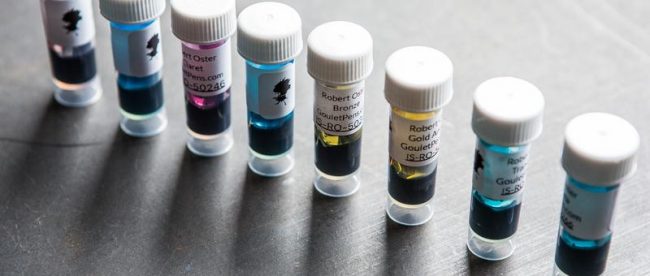The Trail Ink Left Behind

It’s not hard to imagine the situation: you’re in a bit of a bind, maybe because of your own negligence or may because of circumstances beyond your control. Either way, there’s a document which is going to cause all sorts of problems for you. Maybe it’s a contract with terms you no longer like, or perhaps the business you work for has some financial records which you really wish said something else. So you, in a moment of panic, take out a pen and make some adjustments, changing 3s into 8s or something like that. That’s a bad idea — it’s likely illegal — but it’s also something hard to catch. Unless someone investigates with a really keen eye, they’re probably not going to notice.
But there’s something else that can give away your fraudulent misdeed: the ink. That’s because, for more than 50 years, the U.S. government has been sampling ink from thousands of pens, all in an effort to stop fraud like that type described above.
Back in the 1960s, the U.S. Bureau of Alcohol, Tobacco, and Firearms (ATF) began what is now known as the International Ink Library. The idea was simple: collect samples of pen ink from around the world for use in criminal forensics. In the 1980s, the ATF transferred control of the library to the Secret Service (which makes sense given that the Service investigates financial fraud as well as threats against the lives of the President and Vice President). Today, Secret Service agents collect pen samples from around the world on a regular basis. Whenever a pen manufacturer comes up with a new formulation, they provide a sample to the Secret Service. And currently-used pens aren’t the only ones they’re after — agents have acquired samples from most commonly-used pens dating back to the 1920s. In total, the Library has more than 11,000 ink samples in its collection, each one of which has its own unique “fingerprint.”
Today, there’s a digital database of ink types; an ink sample can be matched against one of the library’s 11,000 or so samples in a matter of hours. All the Secret Service needs is a sample of the ink used and, as Popular Mechanics explains, they can learn a lot about your pen from that sample. First, it’s the basic stuff: they “simply take stock of the type and color of ink.” Then they’ll expose the ink to ultraviolet and/or infrared light, looking to see if the colors change — beyond what we can see with the naked eye, different inks absorb different wavelengths. And finally, the agency can do a chemical analysis of the ink itself, using a technique known as “thin layer chromatography”:
This process separates the ink on a thinly coated piece of paper. Using solvents, Secret Service analysts can separate individual bands of color, or dyes. Black ink is never just black, after all. It may be a mix of multiple purple and yellow dyes, or some other combination, so don’t believe your naked eye.
“The chemistry of ink is such that it is rare that the color the human eye perceives is the color the dye is that is used,” [ink library analyst] Joseph] Stephens says. By comparing the bands to the over 11,400 inks in the library, the analysts can pinpoint the manufacturers creating the specific ink.
And in some cases, the ink itself may have a tracker embedded. Per a behind-the-scenes book on the Secret Service, “most ink manufacturers now add tags so that the Secret Service can trace the ink.”
While this information can’t be used to identify the specific pen used — or the specific person using it — it has some creative uses. For example, again per Popular Mechanics, if you “want to cover up insider trading by adding information to a stock worksheet after the fact, then you should have used the same exact pen as the original, since the FBI and the Secret Service have teamed up to crack those kinds of cases simply through ink analysis.” And if you use a pen manufactured in 2017, you better be sure the document you purport to be drafting is dated after that date.
Of, you could just not doctor the document in the first place.
Bonus fact: According to Mental Floss, Secret Service agents do not explicitly take a vow to sacrifice their own lives to save the President. Historian Ronald Kessler told the publication “They never utter that sentence. It’s understood that something like that could happen, but they take every possible step to avoid it.”
From the Archives: Abraham Lincoln Created The Secret Service The Day He Was Shot. We think of the Secret Service as an agency dedicated to protecting the President. As noted above, they’re not. Which led to a really weird coincidence.
